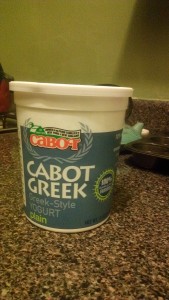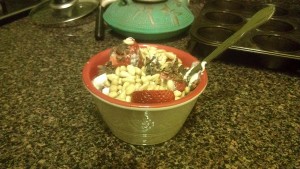One of my roommates in undergrad often used to say that people “go on kicks” for different types of food at different times. He once went on a steak kick, pan frying hefty t-bones once or twice a week.
If a culinary kick is an actual thing, then I am most definitely on a Greek yogurt kick.
Greek yogurt is really only a recent occurrence in my life.
As a teenager, I used to eat yogurt nearly every day when I returned home from the gym. This was before the Greek yogurt moment had arrived in America, so I consumed the “traditional” type, like Dannon brand yogurt.
While living in China and Taiwan after college for a few years, yogurt was a different concept altogether. Whereas yogurt is consumed by spoon in America, it is a semi-beverage in China.
Chinese-style yogurt, literally called “sour milk” or 酸奶, reminded me of melted popsicles. Sweet and watery, it often comes in tubes or containers designed for drinking. I personally didn’t take to it and preferred to drink milk.
The difference between the three yogurts is a matter of macronutrients and consistency.
The Chinese variety is highest in sugar (carbohydrate) content and lowest in fat and protein, giving it a liquid consistency and sweeter flavor.
Greek yogurt is on the other end of the spectrum with a higher fat and protein ratio relative to total calories, which gives it a thicker consistency and more savory flavor. Traditional yogurt in the U.S. is somewhere between these two.
What links all of the yogurt breeds is healthy bacteria.
Microorganism cultures like Lactobacillus bulgaricus and Streptococcus thermophilus are added to yogurt to ferment it. These and other types of bacteria can also support digestive flora, which is good for, you know … digesting and stuff.
In the U.S., Greek yogurt has been at the center of the healthy-delicious food nexus for years. Growing demand for it has spawned shops catering directly to the Greek yogurt market. Here in NYC, where I have lived since returning from China, chains like Pinkberry have popped up around the city. It offers all sorts of yogurt toppings and a simple store aesthetic that pairs well with yogurt. But what Pinkberry giveth in variety it taketh in cash. A medium cup will run you between $5-8.
When you’re on a Greek yogurt kick, five bucks a pop turns into a small fortune real fast. My solution has been to set up a Greek yogurt buffet in my own kitchen.
In the grocery store, I have a reasonable number of options. Before the spawning of brick and mortar Greek yogurt shops, there were already a few established consumer brands. Two of the leaders in the U.S. are Fage and Chobani.
I have found Fage to have the best heaviest texture of the two, which is important for mixing in other ingredients. So for a period of time, I circumvented yogurt shops with Fage at home. And it was good.
Then something better happened. There are a number of groceries around my apartment, and I don’t always know when one offers a product that another is missing. I had settled into the habit of buying the yogurt at one store that was located conveniently on my daily commute path. But on a recent Sunday, when I had more time to break habits, I explored the refrigerated section of another grocery and laid my eyes on this:
I had not heard of the Cabot brand before. The first thing I did was check out the nutritional content. The fat and protein ratio was even higher than the bigger brands. Next, I noticed that the price was a couple of dollars less (around $5.50) than the others, which may be a function of it being a local (New England) brand. The only issue left to resolve was the taste.
Excited to know whether or not my discover would pay off, I pulled out a spoon soon after getting home. Eureka! It was the thickest, most savory Greek yogurt I had tasted yet! Obviously, it only exacerbated my ongoing kick.
So I currently eat a Greek yogurt parfait at least once every two days. Two a day is not unheard of. My favorite toppings are a variety of berry paired with a type of nut, topped with dark chocolate (usually no less than 70% cacao). In the images below, I used strawberries, pine nuts, and cacao nibs.
Post-exercise, I might add some cereal to the mix for a carbohydrate boost (as exercise can provide a “window of opportunity” to replenish glycogen stores in the body).
Aside from the outstanding taste and versatility, there are a number of reasons why I am embroiled in this Greek yogurt kick. Greek yogurt contains healthy bacteria and is a fine source of protein. Equally as important is that when compared to other protein sources like meat, yogurt is not as resource-intensive. It is less taxing on the environment to milk a cow than to raise a cattle to replace another used for meat. (It is also less ethically challenging, I would argue.)
I have a feeling this kick won’t be quelled anytime soon.




